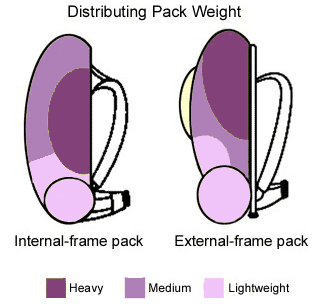Packing a Backpack - How-To
Useful Tips on Packing External-Frame and Internal-Frame Backpacks
The smartest way to get all the gear into your backpack depends on what type of backpack, internal-frame pack or external, you are carrying and where you are going, on-trail or off-trail. Packing your backpack depends on your individual standards of comfort, security and contentment.

Internal-Frame Packs
Whether you are hiking or traveling on- or off-trail, keep your heaviest items close to your back, centered between your shoulder blades.
For on-trail travel, keep heavy items higher inside your pack. This helps focus more of the weight over your hips, the area of your body best equipped to carry a heavy load.
For off-trail exploration, reverse the strategy. Arrange heavier items lower in the main compartment, starting again from the spot between your shoulder blades. This lowers your center of gravity and increases your stability on uneven terrain.
Stuff your sleeping bag into its lower compartment first. Squeeze in any additional lightweight items you will not need until bedtime (pillowcase, sleeping shirt, but nothing aromatic). This will serve as the base of the main compartment, which you'll fill next. Tighten all compression straps to limit any load-shifting.
External-Frame Packs
As with an internal, keep your heaviest items close to your back, near your shoulder blades.
Externals are recommended for on-trail travel only. Load heavier items high inside your pack and close to your body. Doing so centers the pack's weight over your hips and helps you walk in a more upright position.
Pack your sleeping bag in its stuff sack. Finish loading your main packbag, then strap the bag to the lash points on the bottom of the packbag. If rain seems likely, consider stuffing your sleeping bag inside a second stuff sack or wrapping it in plastic.
Tips for Either Pack Style
Make sure some items are easily accessible, packed in places where they can be reached with a minimum of searching:
Map
Compass
Sunglasses
Insect repellent
Snack food
Flashlight/headlamp
First-aid supplies
Water bottles
Rainwear
Packcover
Car Keys
Do not waste empty space. Cram every nook with something. Put a small item of clothing inside your pots, for example. Smaller items, such as food, pack more efficiently in individual units rather then when stored loosely inside a stuff sack.
If you are part of a group, split up the weight of large items (a tent, for instance) with other group members. Do not make 1 person become an involuntary packhorse.
Cluster related small items (such as utensils and kitchen items) in color-coded stuff sacks to help you spot them easily.
Minimize the number of items you strap to the outside of your pack. Gear carried externally may adversely affect your balance. Secure any equipment you carry outside so it does not swing or rattle.
Make sure the cap on your fuel bottle is screwed on tightly. Position it below your food inside your pack in case of a spill.
Carry a packcover. Backpacks, though made with waterproof fabric, have vulnerable seams and zippers. After a few hours of exposure to persistent rain, the items inside your pack could become wet-and thus much heavier.
Quick repair tips:
Wrap strips of duct tape around your water bottles; in case a strap pops or some other disaster occurs, a quick fix could keep you going. Take along a few safety pins in case a zipper fails.
Before you reach the trailhead you should:
Evaluate what outdoor gear and equipment is needed for this specific trip. Be aware of that every ounce of weight counts. For instance, a small steel spoon would gradually become a heavy item at the half-way point on the mountain slope.
Select equipment designed to perform in the toughest overall conditions you anticipate experiencing. It is better to be a little over-prepared
Review a checklist before you leave home to make sure you have everything you need. Click here for a list of REI's trip-planning checklists.
Double-check your older gear to make sure it is in good working order.
Pre-load your pack the night before your hike begins. Or, a few days before your departure date, rehearse packing for this trip. If you are missing something, it is better to discover this fact early.